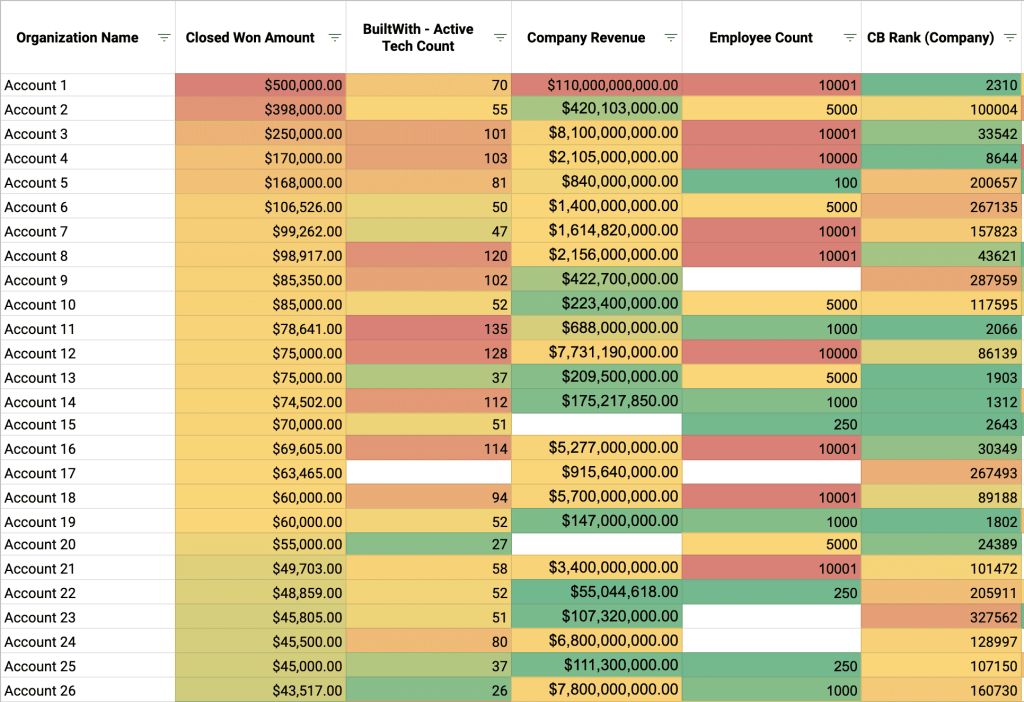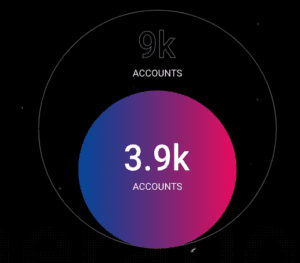A hyper-important part of any go-to-market plan is making sure you understand who your product is for and how best to reach them in the SaaS space. But that’s a whole lot easier said than it is done. So without out any ado whatsoever, let’s get into how to organize a go-to-market plan for your SaaS brand.
Building your TAM (Total Addressable Market)
Who are your potential customers?
A hyper-important part of any go-to-market plan is making sure you understand who your product is for. The honest truth is that it isn’t for everyone. As you get early customers, really try to understand who was involved in the buying process, why they chose you, and what specific pain points you solved. You can do this on an individual persona level, but you also need to do this on a company level as well.
Prioritize based on data
A great way to start building your TAM is by looking at your current customer base. Who are your best customers and why? Run a report of your current customer list and enrich it with a 3rd party tool like Zoominfo, Crunchbase, or Clearbit to identify trends that correlate to contract value.

Most people prioritize company revenue as an indicator of potential contract value. However, that doesn’t always line up. In the example above, we realized that “Active Tech Count” was actually a better indicator of contract value than company revenue.
Once you have an understanding of what makes a good customer for you, use a data tool mentioned above to actually pull a list of every account that fits that criteria. Ideally your TAM pulled from your data sources will be between 10,000 – 20,000 accounts.
Manually verify your TAM
We’re almost to the finish line with the TAM. This last step is the most important and the most time consuming, but it is worth it. Data tools typically have around 60% accuracy. If you start running campaigns to your TAM before manually verifying, that’s a ton of potential waste. You need to be 100% confident that every company in your TAM list could actually be a customer. Make this a Friday team effort activity, hire a virtual assistant, or enlist some interns.

Building your TAM is a crucial first step in any go-to-market strategy, and it fuels the following strategies you’ll read about here.
Review Sites
In order to drive new business, you need to be a part of the conversation. This seems obvious, but it’s a crucial step that a lot of SaaS companies miss when launching their go-to-market strategy.
Where should you be positioned?
Since you’ve established your TAM, put yourself in their shoes. Use the SERP as if you were a potential customer looking for your solution. If I was looking for a sales enablement tool, I would search for something like this.

From there, you can run an analysis in an SEO tool of your choice to see what keywords these directories are ranking for organically. Do they make sense with how your ideal custom would search? What the directory ranks for is only half of the equation though. Take a look at some of the other companies on the list. If someone was to get a quote from 3 companies on that list, would yours be in the same ballpark?
These questions are crucial for understanding if your product should be positioned on any review site you identify.
Building Reviews
Getting positioned on a review site won’t instantly bring you leads. The next thing that needs to be prioritized is actually getting reviews. In our 2022 reality, people shop for software in a similar way they’d shop for anything else. If you’re buying a TV, the first thing you look at is reviews, and the same thing applies to people looking for software.
A lot of these review sites have campaigns to help you build reviews by offering gift cards in exchange for a review. Keep a list of happy customers or keep track of events/milestones in your customer onboarding process to time your review outreach.
Optimize Your Profile
Don’t just create your profile for the sake of creating it. Make sure it’s as optimized as possible. Do you have examples of your work? Are you able to clarify pricing? Do you have a tagline or value proposition that separates you from the competition? All of these pieces are crucial for success on directories.
Direct Response & Paid Social
Now that you’ve built a TAM and have started building your social proof, the next step is getting in front of your ideal customers through outbound marketing. The following steps will help you build a direct response campaign that works.
Upload your TAM
If you want your social campaigns to be successful, you cannot rely on 3rd party targeting or data. Directly upload your TAM to your advertising platforms. You want to be perfectly confident that every account that receives an ad from you is your ICP. As you’re gathering data on performance, make sure you’re consistently updating and adding negative titles. Instead of targeting by title, It’s better to add people/titles you don’t want in order to keep your targeting tight.
Nail your Positioning
Once you’ve got your audiences ready to target, spend a lot of time understanding your positioning and messaging. Why should someone take 30 minutes out of their day to learn more about your software? A great exercise here is focusing on your differentiators. Don’t write about why you’re better, write about why you’re different. A prospect should feel like they’re not doing their job to the best of their ability if they don’t take a meeting with you
Order of Operations
In order to spend your budget efficiently with the most learning, start with running conversation ads on LinkedIn. You can send in mass quantities and make sure you’re getting in front of the right people. From there, you can take your learnings and expand into sponsored content. When you’ve nailed that down, you can use a tool like Clearbit or Metadata to expand into Facebook. This makes your product completely unmissable across the most dominant social channels.
Google Ads
Now that you’re consistently in front of your TAM through direct response, and have built your reviews on 3rd party directories, you can expand your reach through Google Ads. While Google Ads has the crucial aspect of intent (i.e. someone is actually searching for your product), it doesn’t mean everyone searching will fit your ICP. However, the following suggestions should set you up for Google Ads success.
Financial Performance
This is a massive area to start on Google Ads. Make sure you’re utilizing Offline Conversion Tracking so you can see what keywords are driving things further down the funnel (SQLs, Opps, and Revenue). From there you can start benchmarking what financial performance you need to be successful. Are you able to acquire customers and a cost-per-acquisition (CPA) that makes financial sense? Do you need to adjust your price or contract length to make up for a high CPA? Look at price, gross margin, lifetime value, average order value, lifecycle conversion rates, etc. when running your financial modeling across keywords and the Google Ads channel as a whole.
Differentiate Yourself
As we mentioned above in the Direct Response section, people buy different, not better. When looking at the keywords you want to show up for, identify what the competition is saying. On your ads and your landing pages, ask yourself, “what do I need to communicate to my ICP to prove that we are different?” This simple exercise can go a long way in making sure Google Ads is a successful channel for your product.
Organic Marketing
What Would Your Ideal Customer Search?
If you were your ICP, and you were looking for a software that has what you offer, what would you type and where would you go? What does the search engine results page (SERP) look like? Is it even realistic to rank for that core keyword, or is the SERP dominated by 3rd party review sites?
Because you don’t have the ability to filter out audiences who find your site organically, this is a crucial step in making Organic a successful search channel early in your GTM plan.
Create Good Content
This seems like an obvious step, but too often you’ll see a piece of content ranking organically that you know was only written for that purpose. But realistically, if the content isn’t valuable, why spend all the effort writing it and trying to get it to rank? Again, put yourself in your ICP’s shoes. If you read your post/content, would you actually hire you? If you aren’t 100% confident that someone who read that post would be more likely to buy your product, don’t post the content.
Focus on Purchase Intent Before Information Intent
The further your content goes away from purchase intent, the less impactful it can be in driving revenue. This isn’t to say that thought leadership pieces aren’t important, but when launching a Go-to-market plan, focus on the keywords that are closest to purchase intent.

When I say purchase intent, I mean keywords that are relevant to someone who is making a buying decision. When someone is in the market for sales enablement software, what other things are they looking for? Creating content around a price/cost guide for sales enablement software would be a great way to take up more market share when people are actively looking for information that helps them buy your product.
Thought Leadership
Taking up market share through your own site ranking on Google is a great start, however, it’s crucial to expand your reach to other places where your ideal customers trust their information.
ICP Watering Holes
Outside of Google Search, where does your ICP learn and interact with others? A great way to identify these goes back to how we initially built our TAM, just ask them! Customer and prospect interviews are a great way to get this information. Podcasts, publications, and conferences are a great place to start getting your name out to your ICP. On top of talking to clients, you can use a tool like SparkToro or Google Search Informational queries to see who ranks.
Build Relationships
Once you’ve identified the watering holes where you can actively educate your ICP, it’s time to build relationships. Most editors, producers, or assistants get hundreds and hundreds of emails a day from people who want to be on their show, on their blog, etc. How can you stand out from the noise? Connect with them on social media, find their number on Zoominfo and give them a call, send them a bottle of wine or a gift box. Similarly to ad copy or messaging, it’s crucial to differentiate yourself here. What do you provide to their audience that they can’t get from anyone else?
Don’t Be Picky
When you’re starting off, don’t be picky with your outreach. Try and get on as many podcasts, webinars, guest posts, speaking engagements as possible, and be consistent. When you’ve built up a name for yourself and your product, then you can get more specific and choosy.
Partnerships
Identify your Vendors/Tech
Growing a list of partners is a great way to jumpstart your go-to-market strategy. What tech do you or your clients use in your industry that isn’t a direct competitor? Can you work alongside these companies for content or referrals?
Start Wide
Similar to the thought leadership approach, don’t be picky when you’re starting off. How can you partner with as many vendors or technology as possible? Take a similar approach as you would with outreach for speaking engagements, podcasts, or guest posts. Build a relationship with their head of partnerships. What are their specific goals? How does a partnership with you help them hit their goals? How can they help hit your goals? These types of conversations will be massive when trying to grow your partners.
You need to give before you can get. What can you give to your partners that benefits them? Some of these things could be referrals, content, insights, shoutouts, etc. If you can be kind and generous, your partnerships will truly be partnerships.
Awareness/Brand/Programmatic
To wrap up this go-to-market approach, focus on getting your brand/product in front of your TAM through focused display advertising. I put this last because this in itself won’t immediately drive leads or revenue, but this combined with all of the things above can make marketing and sales jobs easier.
TAM Awareness
A crucial goal of your brand/programmatic campaigns should be to make sure that your TAM knows exactly what your software offers. Chances are you can use your software to solve a lot of various pain points. We want to make sure that our TAM is fully aware of all of these pain points that we can cover.
Ideally, you want your TAM to be getting 7+ impressions a month with specific messaging and positioning. Try to be as shockingly memorable as possible. Nobody notices ads that look like everything else. Be bold, stand for something, and express yourself creatively.
Mix it Up
Nobody wants to see the same ad multiple times in a row. Make sure you’re consistently updating your creative so that your audience feels like they’re getting a new ad every month. The key is figuring out how to tell your audience about your message in a different way.
Conclusion
Hopefully you walked away from this read with some actionable steps to take in terms of building out your own go-to-market strategy. But, if not, you’re still in good hands. Luckily, I know of these go-to-market strategists who know a thing or two about SaaS.
-
Andrew Choco
Did you enjoy this article?
Share it with someone!
